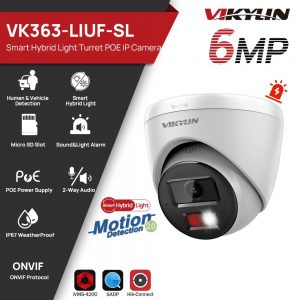One day while i having dinner and chatting with a friend who works in catering, he suddenly asked a question: Why are the images captured by ip surveillance cameras that costs several hundred yuan not as clear as those captured by a mobile phone with a similar cost? This question is indeed quite interesting. I specifically checked the information on it.
When we compare the videos footage from ip surveillance cameras and cell phone, we often feel that the clarity of the former is not as good as that of the latter. Why is this? In fact, this phenomenon involves the comprehensive consideration of multiple factors. The following is a technical blog that provides an in-depth analysis of the difference in video quality between surveillance cameras and mobile phones.

1. POE IP Cameras Resolution
Resolution refers to the horizontal and vertical pixels visible in an image. It determines the clarity and detail of an image, usually expressed in terms of the number of pixels. High-resolution images can show more detail and are more capable of subtle changes, so they look sharper.
In general, the resolution of mobile phones is higher than that of most poe ip cameras. Currently, the screen resolution of smart phones has reached 4K, while the resolution of most ip poe network camera is less than 2K. Therefore, on a screen of the same size, the picture of the mobile phone will be clearer.
2. Network IP Camera Pixel Density
Pixel density refers to the number of pixels per inch. It’s directly related to resolution, but is also affected by screen size. Within the same screen area, the higher the pixel density, the clearer the image will be.
In general, mobile phone screens are relatively small, so the pixel density is usually high. network ip camera generally require a larger field of view, so the screen size is relatively large, but the pixel density is relatively low. This is also one of the reasons why the picture clarity of mobile phones is better than that of surveillance cameras.
3. IP Camera POE Pixel Quality
In addition to resolution and pixel density, pixel quality also directly affects the clarity of the image. Pixel quality refers to the amount of information stored in each pixel, including color, brightness, contrast, etc. If the pixel quality is low, the image will lose a lot of detail and the colors will become dull.
Since poe surveillance cameras are designed for security monitoring and action capture, relatively little emphasis is placed on pixel quality. Therefore, ip surveillance cameras usually use compression technology to reduce the amount of data and reduce the picture quality to an acceptable range. When shooting videos on mobile phones, users usually want to capture more details, so the pixel quality of mobile phones is much higher than that of ip poe network camera.
4. IP Surveillance Camera Lens
Camera lenses also have a huge impact on image quality. If a lens is poorly designed, has poor material quality, or is severely aged, it will lead to poor image quality, and may cause significant distortion, color deviation, and other issues.
There are also clear differences in video camera lenses between network video camera and cell phones. Generally speaking, the lenses of ip surveillance cameras for home are designed to capture the maximum field of view, and durability and price are important considerations, while the lenses of mobile phone cameras focus on quality and resolution to meet users’ high-definition needs.
5. Light Conditions of IP Surveillance Cameras
Lighting conditions also have a big impact on image quality. Good light conditions can provide bright, detailed images, while under low light or backlight conditions, the image will appear dim and lose many details.
There are also significant differences in lighting conditions between network surveillance cameras and mobile phones. Smartphones typically use a variety of technologies to optimize image quality, including automatic white balance, automatic exposure, and more. Video Surveillance cameras may use infrared technology to enhance image quality in low-light conditions, but this technology also reduces resolution and picture details.
To sum up, the design goals and usage scenarios of videos captured by security surveillance cameras and mobile phones are different, so there may be differences in picture clarity. Compared with poe ip cameras, our mobile phones are usually used for important occasions such as taking pictures or shooting videos, so they require higher picture clarity to ensure picture effects and detailed performance. In addition, factors such as resolution, pixel density, pixel quality, ip camera lens and lighting conditions will also affect the clarity of the image. However, it should be noted that these factors are not absolute advantages and disadvantages, but need to be selected and applied according to specific usage scenarios.





